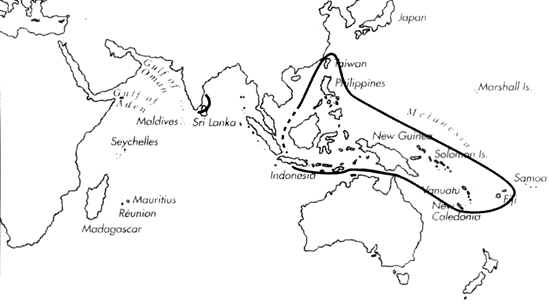Range: C. o. ochroleucus: Taiwan and Philippines. C. o. tmetus: Papua New Guinea to Fiji; Indonesia and India.
Description: C. o. ochroleucus (Pl. 18, Figs. 16-17) moderately large to large, C. o. tmetus (Pl. 18, Figs. 18-21) medium sized to moderately large; moderately solid to solid. Last whorl narrowly conoid-cylindrical to ventricosely conical; outline convex near shoulder, almost straight below. Aperture somewhat wider at base than near shoulder; siphonal fasciole usually prominent and siphonal notch curved to dorsal side in larger specimens. Shoulder angulate (C. o. ochroleucus) or subangulate (C. o. tmetus). Spire of moderate height, outline concave. Larval shell of about 3-3.5 whorls, maximum diameter about 0.8-0.9 mm. Teleoconch sutural ramps variably concave, with 1-2 increasing to 4-7 spiral grooves; additional spiral striae on last 2 ramps. Abapical half of last whorl with pronounced narrow to wide spiral grooves, either separating regularly spaced ribbons or ribbons and ribs in varying sequence.
| Shell Morphometry | ||
|---|---|---|
| L | 55-88 mm | |
| (C. o. ochroleucus; 45-74 mm C. o. tmetus) | ||
| RW | 0.15-0.40 g/mm | |
| (C. o. ochroleucus: L 55-83 mm; 45-74 mm C. o. tmetus: L 55-68 mm) | ||
| RD | 0.47-0.54 | |
| PMD | 0.78-0.85 | |
| RSH | 0.12-0.19 | |
Ground colour cream in C. o. ochroleucus. Last whorl with spiral bands and axial streaks of yellowish brown to brown often leaving only a narrow ground-colour band of varying prominence near centre. Larval whorls light brown, adjacent 3-4 sutural ramps solid brown. Later sutural ramps with tan axial markings often producing regularly alternating dark and light spots at outer margins of middle ramps. Aperture yellowish tan to light orange. In C. o. tmetus, last whorl light to dark brown except for yellowish to orangish brown basally; a pale central or subcentral spiral band sometimes present. Larval whorls and a few adjacent sutural ramps brown. Later sutural ramps pale grey or cream, with dark brown curved streaks and marginal spots; dark markings more numerous, larger and confluent on last 2 ramps. Aperture dark orange or yellow.
Periostracum dark brown, moderately thick, opaque, and velvety smooth.
Foot of C. o. tmetus brown (Richards, 1988).
Radular teeth of C. o. ochroleucus with an adapical barb opposite a short blade; serration of about 11-16 pointed denticles ends in a well- separated posterior cusp; shaft distinctly broader at base than adapically, base with a spur (Röckel, 1985b).
Habitat and Habits: In 6-60 m; on muddy bottom and on rocky substrate with patches of rubble and coarse sand. In E. New Britain, dark brown variant in 15-25 m, light brown variant below 25 m (Petuch, 1974; Estival, 1981; Richards, 1988).
Discussion: C. ochroleucus is very similar to the sympatric C. flavus; for comparison, see DISCUSSION of the latter species. C. radiatus has a low spire (RSH 0.05-0.12) with prominent substural ridges, its aperature lacks yelloe or orange shades, and its last whorl is more cylindrical and less conical (PMD 0.74-0.82) and has a light spiral band at shoulder rather that near center. C. pilkeyi as represented by the holotype from the Solomon Is. has only minor differences from C. ochroleucus from Philippines but agrees with the latter in important conchological characters (see DESCRIPTION). Because of the striking similarity of specimens from Fiji, Vanuatu and Papua New Guinea that agree with the description of C. pilkeyi we consider the allopatric populations they represent a subspecies of C. ochroleucus. C. tmetus refers to a juvenile specimen of C. pilkeyi. As C. tmetus has priority over C. pilkeyi, the correct name for the eastern subspecies is C. o. tmetus. C. praefectus, C. fasciatus and C. eburneus(Röding) are synonyms of C. o. ochroleucus.

C. ochroleucus range map
This section contains verbatim reproductions of the accounts of 316 species of Conus from the Indo-Pacific region, from Manual of the Living Conidae, by Röckel, Korn and Kohn (1995). They are reproduced with the kind permission of the present publisher, Conchbooks.
All plates and figures referred to in the text are also in Röckel, Korn & Kohn, 1995. Manual of the Living Conidae Vol. 1: Indo-Pacific Region.
The range maps have been modified so that each species account has it own map, rather than one map that showed the ranges of several species in the original work. This was necessary because each species account is on a separate page on the website and not confined to the order of accounts in the book.